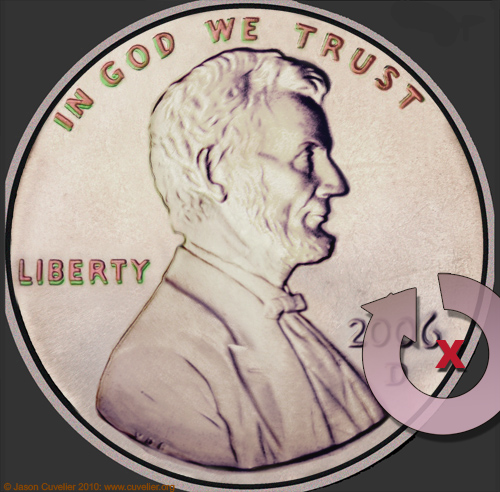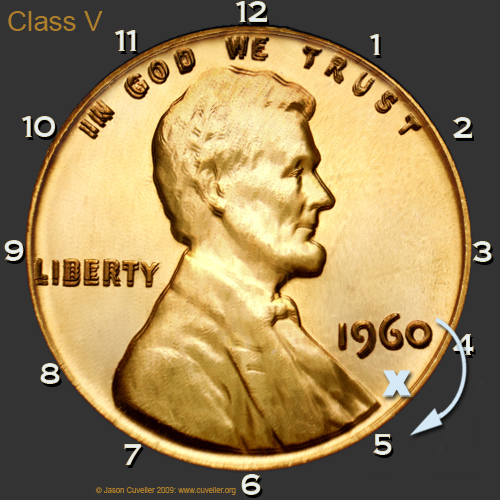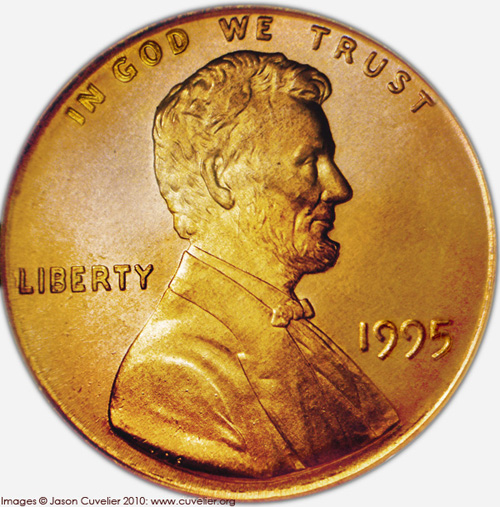Doubled Die Class 5 – Pivoted Hub Doubling

Class V Doubled Dies are often referred to as the cousins of Class I Doubled Dies as they have such a close relationship. If one understands Class I, Rotated Hub Doubling, then understanding Pivoted Hub Doubling should be a snap. Both classes are rotated, however with Pivoted, the center of rotation is near or at the rim. Rotated may not always be dead center, nevertheless, as long as it is in the central area, it is considered Class I whereas anything near the rim is Class V.
The characteristics are also similar with one important difference, while it is rotated either Clockwise (CW) or Counter-clockwise (CCW), the degree of rotation (or the spread) is strongest opposite the pivot point and displays almost no doubling at the pivot point itself. Class I, even if it is mild, will show some degree of rotation all away around.
Below is a facsimile of a fictitious 1960P DDO with Class V doubling centered near the date in-between coordinates K5 and K4 near the date. K5 essentially represents an area along the rim that coincides with numbers on a clock. Notice how the doubling is not present at the date but very strong on the direct opposite side – follow it around it gradually decreases.

A similar DDO to the illustration above is 1995P DDO-001. It has its pivot point near K4 and shows strong CW doubling in IN GOD and parts of LIBERTY with lesser doubling in WE TRUST.


For clarity below is another facsimile of a fictitious DDO also with a K4 pivot point. The hubbings are colored green (first) and red (second).

Our last two illustrations are 1980P DDO-001 with a K11 pivot point showing strong doubling in the date, a little less severe in LIBETY and not at all in the motto. For contrast, 1951D DDO-001 has a pivot point near K6 and shows strong doubling in IN GOD WE, lesser in TRUST and on the Y of LIBERTY and non in the date. Notice the notching is stronger than the separation lines.


Class 1, Rotated
A class I doubled die results when the die receives an additional hubbing that is misaligned in a clockwise or counterclockwise direction.
Class 2, Distorted
A class 2 doubled die results when the hub’s design moves toward the rim between hubbings.
Class 3, Design
A class 3 doubled die results when a hub bearing a different design stamps a die bearing another design.
Class 4, Offset
A class 4 doubled die results when the die receives an additional hubbing that is misaligned in an offset direction.
Class 5, Pivoted
A class 5 doubled die results when the die receives an additional hubbing that was misaligned via rotation with a pivot point near the rim.
Class 6, Distended
A class 6 doubled die results when the die receives an additional hubbing from a hub that was distended.
Class 7, Modified
A class 7 doubled die results when the hub is modified between the die’s hubbings (e.g., a design element was chiseled off).
Class 8, Tilted
A class 8 doubled die results when a die and/or hub is tilted during a hubbing.
